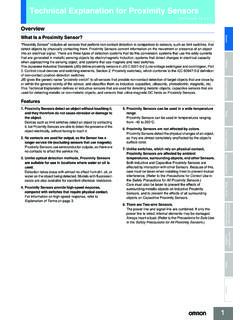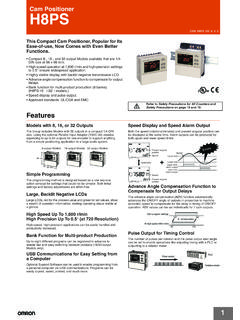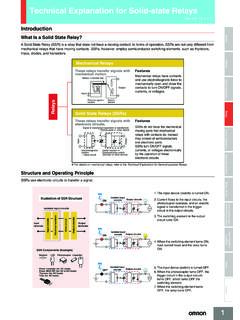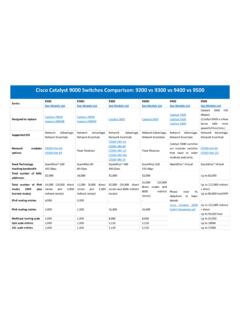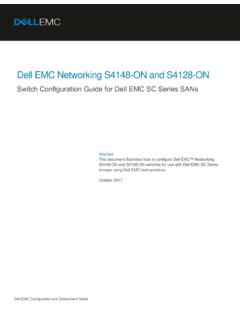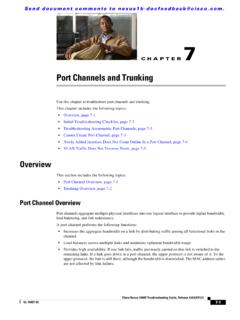Transcription of Technical Explanation for Temperature Controllers
1 1 CSM_Temperature_TG_E_6_3 SensorsSwitchesSafety ComponentsRelaysControl ComponentsAutomation SystemsMotion / DrivesEnergy Conservation Support / Environment Measure EquipmentPower Supplies /In AdditionOthersCommonTechnical Explanation for Temperature ControllersIntroductionWhat Is a Temperature Controller?A Temperature Controller is a device that is used to control a heater or other equipment by comparing a sensor signal with a set point and performing calculations according to the deviation between those values. Devices that can handle sensor signals other than for Temperature , such as humidity, pressure, and flow rate, are called Controllers . Electronic Controllers are specifically called Digital ControlTemperature Controllers control Temperature so that the process value will be the same as the set point, but the response will differ due to the characteristics of the controlled object and the control method of the Temperature Controller.
2 Typically, a response shown in Figure (2), where the set point is reached as quick as possible without overshooting, is required in a Temperature Controller. There are also cases such as the one shown in Figure (1), where a response quickly increases the Temperature even if it overshoots is required, and the one shown in Figure (3), where a response slowly increases the Temperature is required.(1) Response where the process value settles on the set point while repeatedly overshooting and undershooting(2) Proper response(3) Response where the process value slowly reaches the set pointTemperature Control Configuration ExampleThe following example describes the basic configuration for Temperature pointTimeSet pointTimeSet pointController Control outputControlled object Temperature Controller ControllerA controller is a magnetic switch that turns the current to a heater ON and OFF, a valve that supplies fuel, or some other type of device that is used to heat or cool a furnace, tank, or other controlled object.
3 If the output of the Temperature Controller is a relay output, a relay may also function as the controller. Temperature SensorA Temperature sensor measures the Temperature of the location where the Temperature control is required. It converts the Temperature to a physical quantity of a voltage or resistance and outputs that. Temperature ControllerA Temperature Controller converts the output from a Temperature sensor to the process value and outputs the control output to the controller so the process value will approach the set point. Thermocouple Platinum resistance thermometer Thermistor SSR Magnetic Switch Power Controller Relay output Voltage output Current outputTechnical Explanation for Temperature Controllers2 SensorsSwitchesSafety ComponentsRelaysControl ComponentsAutomation SystemsMotion / DrivesEnergy Conservation Support / Environment Measure EquipmentPower Supplies /In AdditionOthersCommonTemperature Controller PrincipleThe following figure shows an example of a feedback control system used for Temperature major parts of the feedback control system are built into the Temperature Controller.
4 A feedback control system can be built and Temperature can be controlled by combining a Temperature Controller with a controller and Temperature sensor that are suitable for the controlled of the Controlled ObjectBefore selecting a Temperature Controller or Temperature sensor, it is necessary to understand the thermal characteristics of the controlled object for proper Temperature blockControllerControlled objectDeviationSet pointManipulated variableControlled variableTemperature SensorExternal disturbancesNoiseDeviationSet pointPID controlON/OFF controlManipulated variableControl blockInput sectionOutput sectionMeasured variableProcess valueMeasured variableTemperature ControllerProcess valueConfiguration of a Feedback Control SystemTemperature Controller Configuration Heat capacity, which indicates the ease of heating, varies with the capacity of the furnace.
5 Static characteristics, which indicate heating capability, vary with the capacity of the heater. Dynamic characteristics, which indicate the startup characteristics ( excessive response) of heating, vary with heater and furnace capacity that can affect each other in a complex way. External disturbances cause Temperature changes. For example, the opening or closing of a door on a constant Temperature tank can cause external disturbances that generate Temperature changes. Characteristics of the controlled object Heat capacityStatic characteristics Dynamic characteristics External disturbances Technical Explanation for Temperature Controllers3 SensorsSwitchesSafety ComponentsRelaysControl ComponentsAutomation SystemsMotion / DrivesEnergy Conservation Support / Environment Measure EquipmentPower Supplies /In AdditionOthersCommonControl MethodsAs shown in the graph below, if the process value is lower than the set point, the output will be turned ON and power will be supplied to the heater.
6 If the process value is higher than the set point, the output will be turned OFF and power to the heater will be shut off. This control method, in which the output is turned ON and OFF based on the set point in order to keep the Temperature constant, is called ON/OFF control action. With this action, the Temperature is controlled using two values ( , 0% and 100% of the set point). Therefore, the operation is also called two-position control action (or proportional control action) is used to output a manipulated variable (control output variable) that is proportional to the deviation in order to decrease the deviation between the process value and set point. A proportional band is set centering on the set point, and the output is determined with the following rules. A manipulated variable that is proportional to the deviation is output when the process value is within the proportional band.
7 A 100% manipulated variable is output when the process value is lower than the proportional band. A 0% manipulated variable is output when the process value is higher than the proportional control than the ON/OFF control action is possible because the output is gradually changed near the set point according to deviation. However, if the Temperature is controlled with the proportional action alone, it will stabilize at a Temperature that is off from the set point (offset).Note:If a Temperature Controller with a Temperature range of 0 C to 400 C has a 5% proportional band, the width of the proportional band will be converted into a Temperature range of 20 C. In this case, a full output is kept turned ON until the process value reaches 90 C, and the output is OFF periodically when the process value exceeds 90 C, provided the set point is 100 C. When the process value is 100 C, there will be no difference in time between the ON period and the OFF period ( the output is turned ON and OFF 50% of the time.)
8 I action (or integral action) increases or decreases the manipulated variable according to the size and duration of the Temperature will stabilize at a Temperature off from the set point (offset) with only the proportional action, but the deviation with the passage of time will be decreased and the process value will be the same as the set point by combining the proportional and integral Control ActionP Action (Proportional Control Action)Hysteresis Characteristics of ON/OFF control action Set pointTime ON Heater OFF Control output100%50%0%ONOFFT emperatureProportional bandSet point 100 C110 C90 CI Action (Integral Control Action)Set point Set point Offset Time A narrow proportional band is set. A narrow proportional band is wide proportional band is set. A wide proportional band is set. Control output 100 (%) 50 0 HuntingOvershootingSet pointTimeTimeControl output100(%)500 Set pointTimeA short integral time is long integral time is ceases to (proportional and integral control) actionP (proportional control) action onlyOffsetA short integral time is long integral time is Explanation for Temperature Controllers4 SensorsSwitchesSafety ComponentsRelaysControl ComponentsAutomation SystemsMotion / DrivesEnergy Conservation Support / Environment Measure EquipmentPower Supplies /In AdditionOthersCommonD action (or derivative action) provides a manipulated variable in response to abrupt changes in the process value, due to factors such as an external disturbance, so that control will quickly return to the original proportional and integral actions both corrects the control results, so the response to abrupt changes is delayed.
9 The derivative action compensates for that drawback and provides a large manipulated variable for rapid external control is a combination of proportional, integral, and derivative control actions. The Temperature is controlled smoothly here by proportional control action without hunting, automatic offset adjustment is made by integral control action, and quick response to an external disturbance is made possible by derivative control PID control uses a single control block to control the responses of the Temperature Controller to a set point and to external disturbances. Therefore, the response to the set point will oscillate due to overshooting if importance is placed on responding to external disturbances with the P and I parameters set to small values and the D parameter set to a large value in the control block. On the other hand, the Temperature Controller will not be able to respond to external disturbances quickly if importance is placed on responding to the set point ( , the P and I parameters are set to large values).
10 This makes it impossible to satisfy both the types of response in this PID control provides good response for both response to the set point and an external Control(1)Response to the set point will be slow if response to the external disturbance is improved.(2)Response to the external disturbance will be slow if response to the set point is PID Control(3)Controls both the set point and the external disturbance Action (Derivative Control Action)PID ControlSet pointSet pointTimeA long derivative time is output100(%)500A short derivative time is long derivative time is short derivative time is (proportional and derivative control) actionP (proportional control) action onlyExternal disturbancePID controlTwo PID ControlResponse to set pointResponse to external disturbanceTechnical Explanation for Temperature Controllers5 SensorsSwitchesSafety ComponentsRelaysControl ComponentsAutomation SystemsMotion / DrivesEnergy Conservation Support / Environment Measure EquipmentPower Supplies /In AdditionOthersCommonExplanation of TermsControl TerminologyHysteresisON/OFF control turns the control output ON and OFF at the set point, so if there are small amounts of noise near the set point, the output will turn ON and OFF frequently (which is called chattering).

